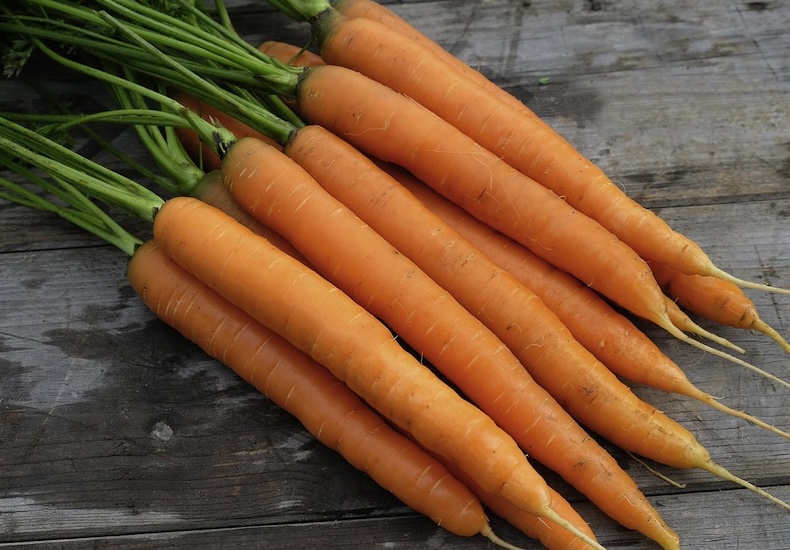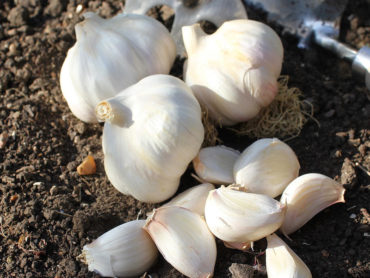Carrots aren’t the easiest crop to grow, but with a few tips from these carefully chosen garden bloggers, YouTubers and Instagram growers, you’re sure to have a successful harvest. One of the most versatile vegetables in the garden, carrots are equally delicious raw in summer salads or slow-cooked in winter stews. If you’ve struggled to get your seeds to germinate or keep your crop free of carrot fly, you’ve come to the right place!
Browse our full range of carrot seeds for inspiration.
Contents:
- Best advice on preparing the soil for carrots
- Best advice on sowing and germinating carrot seeds
- Best advice on avoiding pests and diseases
- Best advice on carrot varieties to try
Best advice on preparing the soil for carrots
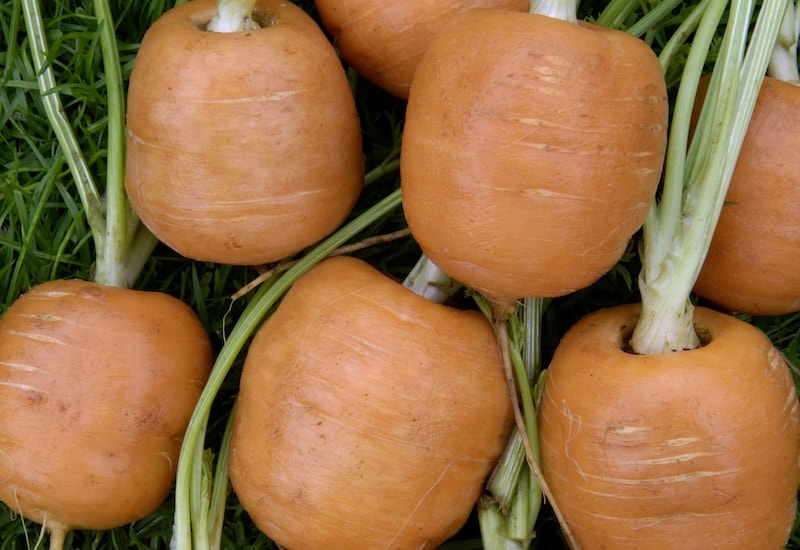
Image: Carrot Seeds ‘Rondo’ from Suttons
Gail from Growing Healthy Kids likes to grow carrots with her children, but they have really heavy clay soil. If you don’t have the light, sandy soil that they prefer, she recommends digging plenty of leaf mould into your bed over the winter or “growing the stunt rooted varieties”. She says that this year, “we are trying them in a raised planter we built out of recycled timber.” See her full article for tips on how to get the kids involved. Spoiler alert: they love growing the multi-coloured varieties that come in red, orange, yellow, purple and white…
Over at Up The Plot, Andrew has been successfully growing carrots for years in his heavy clay no-dig beds. He explains that carrot seeds need warm soil to germinate, and the problem with clay is that it takes longer to warm up. “Once started in warmer top soil, their growth can be stunted when they reach the colder clay below.” If you also garden on clay, Andrew’s top tip is to simply to delay starting them off, as “later sowings will usually be more successful, particularly if the spring is a cool one.”
If you have the time and space to build a dedicated raised bed for your carrots, Tony O’Neill from Simplify Gardening recommends filling it entirely with sharp sand. You then use a piece of drainpipe to create deep holes before filling them with finely sieved compost. The carrots will grow straight and long, year after year. This is just one of Tony’s three fantastic methods – watch his full video for other ideas to try.
Pete from Real Men Sow grows maincrop carrots like ‘Autumn King’ in containers so he can fill them with a mixture of peat-free soil and leaf mould. His favourite container is an old council recycling box that’s “40cm wide, 35cm deep and 50cm long, and already has a few holes pre-drilled in the bottom for drainage”. Pete says he doesn’t worry about rows when sowing in containers. He just aims for an even spread.
Best advice on sowing and germinating carrot seeds
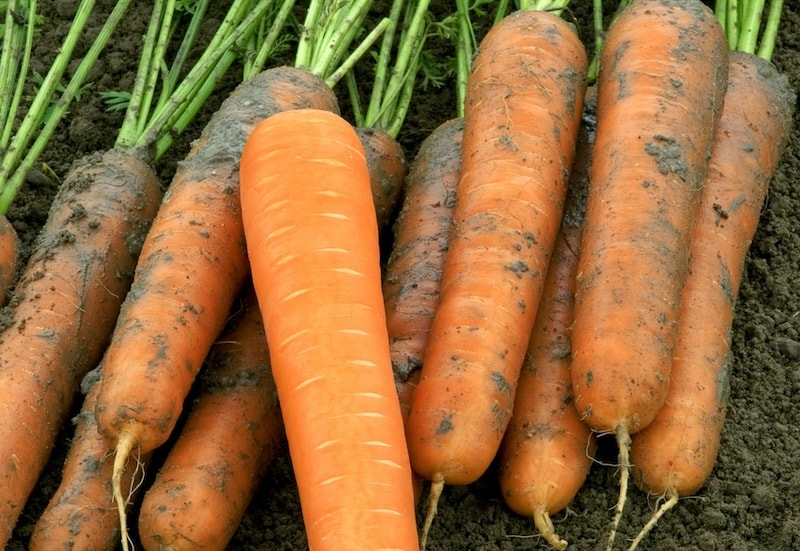
Image: Carrot ‘Volcano’ from Suttons
Having grown exhibition quality carrots in the past, Dan from Allotment Diary knows his stuff. He grows his in raised sandboxes and pops a small plastic collar around the tiny carrot seeds to stop them washing away before they germinate. The collars also help him to earth up the carrot shoulders if they start to turn green in the sunlight. Watch his YouTube video for a demo, and check out his Instagram post for a peek at his impressive harvest.
Over on the YouTube channel Terry King’s Allotment Gardening on a Budget, Terry also likes to sow his carrot seeds into raised beds containing regimented rows of individual yogurt pot collars. Interestingly, he doesn’t handle his seeds, in case the oil on his hands adversely affects them. Once they’re all sown, he makes tiny cloches for each seedling from recycled water bottles. These clear covers create the perfect amount of condensation to help the seeds germinate.
Do your carrot seeds often fail? Over at Huw Richards’ excellent YouTube channel, he beautifully explains that this is probably due to lack of moisture. In his video, he thinly sows his carrot seeds directly into straight drills, covers them lightly with soil, and then lays lengths of wood along each row to trap the warmth and moisture beneath. Huw checks every few days and, as soon as the seeds have germinated, he removes the wood.
Because carrots don’t like to be disturbed, most gardeners direct sow them into their final position straight away. At YouTube channel from_plot_plate_no_dig, Carl experiments with sowing his carrot seeds into carefully adapted root trainers instead. The clever part? Because he has cut larger holes in the trays, he doesn’t need to transplant the seedlings as they get bigger. He simply plants out the entire tray when they’re ready to go outside! Not convinced? Take a look at his video short to see how his carrot harvest turned out!
“Anyone that tells you carrots are easy to grow is lying,” says Dr Rachel Greenhill from @rachels.allotment. With a PhD in crop improvement and food sustainability, this grower has lots of interesting tips to share! To prevent another crop of small forked carrots, Rachel decided to experiment with starting the seeds in toilet roll tubes before planting them out. “The good thing about these cardboard rolls is that they break down pretty quickly,” she says. Follow her on Insta to see how the new technique works!
Best advice on avoiding pests and diseases
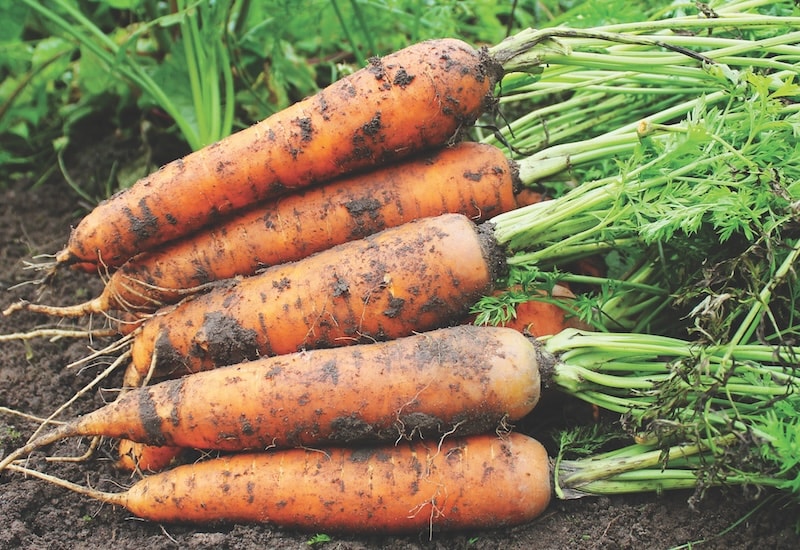
Image: Carrot Seeds – F1 Resistafly from Suttons
Carrot fly is “a small black-bodied fly whose larvae feed on the roots of carrots…causing them to rot,” explains Carol Barlett from The Sunday Gardener. She says that disturbing the foliage, especially when thinning your carrots, releases the smell and attracts the destructive pests. According to this experienced gardener, “the only sure-fire way to prevent carrot fly is to erect a physical barrier using very fine mesh.”
YouTuber Tony C Smith tries to outsmart carrot fly by using rolls of ‘Autumn King’ carrot seed tape, as opposed to traditional packets of seeds. Because the tape is pre-loaded with perfectly spaced seeds, it should mean that less thinning is required as the carrots grow. Less thinning hopefully means fewer pests! Watch his video to learn more.
“I ALWAYS get carrot fly no matter how much I companion plant,” says Katrina from @homegrown.garden. Because she doesn’t like to use netting, she’s set up a vintage-style, steel raised bed in which to grow her carrots away from the ground. And if that isn’t deterrent enough, she’s chosen a ‘Resistafly’ variety too. Take a look at the photos of ‘project carrot’ over on Katrina’s Insta. (By the way, Suttons is the approved UK supplier for the Australian-made galvanised steel raised bed she’s used!)
Writing for Garden Patch, Kirsteen Mackay says that aphids are the other main pest that affect carrots. They “suck the sap” out of your plants leaving a sticky residue “which encourages sooty black mould to grow, slowly killing your crops.” She says there are a few ways to control the problem, including making sure you have lots of their natural predators in the garden to keep them under control. Read her full post for more tips.
Best advice on carrot varieties to try
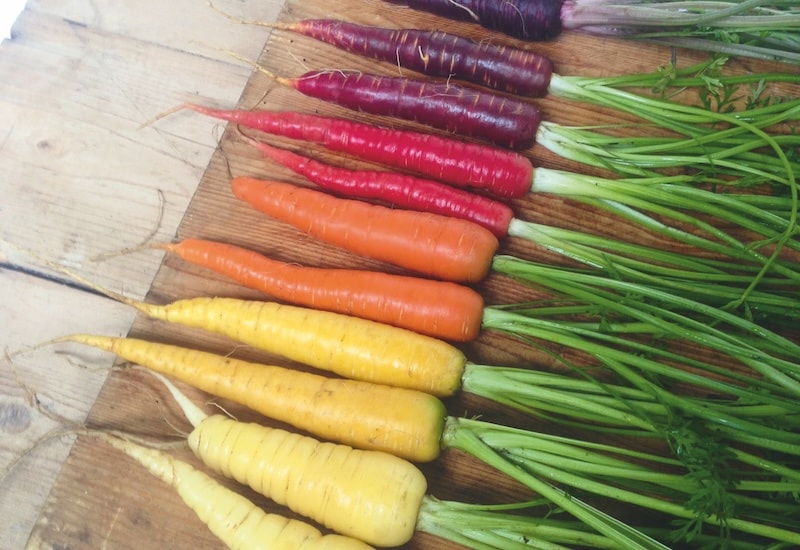
Image: Carrot ‘Rainbow Mix’ from Suttons
Over at Steve’s Seaside Kitchen Garden & Allotment, Steve’s helpful video about growing carrots is definitely worth a watch. He likes to grow the ‘Eskimo’ winter variety for its excellent cold tolerance and flavour. The other advantage of these carrots is that they’re happy to stay in the ground until needed. He sows the seeds all at once in mid-May, and harvests the roots as required until May the next year! Have a read of his free ebook chapter all about growing carrots for more advice and follow-on videos.
Not only did Katie from @allaboutlottie sow her early ‘Amsterdam’ carrot seeds into modules in January, she then successfully thinned and transplanted them into a VegTrug to grow on. Just visit her post to see the fantastic results! She also recommends growing ‘Chantenay’ carrots which she multi sows and harvests as baby carrots. “I normally just scrub them, remove the tops and roast them.. they make a great quick crop,” she enthuses.
There’s no better recommendation than “would try growing these again next year,” which is what @my_veg_adventures said about their ‘Chantenay’ carrots. Having grown them for the first time, they were a “bit of a mix of shapes and sizes,” but the most important test is flavour, and “they were lovely!” Follow this Scottish veg grower on Insta for practical tips.
“Fancy restaurants would sell these for a fortune!!” exclaims Sara from @saras_allotment, when she reveals her crop of sweet and delicious ‘micro carrots’. Whether or not she intended them to turn out this way, she’s absolutely right. Take inspiration from her container-grown beauties and get any leftover carrot seeds started in empty pots…
Vegan recipe developer and blogger Gina Burgess says that whichever variety of carrot you choose to grow, don’t just concentrate on the root and forget about the foliage. Not only are the leafy greens edible, they’re highly nutritious! “Carrot greens can be…added to smoothies for an extra boost of nutrients,” says Gina. Or for a more savoury option, “carrot greens can be used to make pesto or added to curries for added depth of flavour.”
We hope these expert tips will help you to grow bumper crops of sweet, crunchy carrots from seed. You’ll find more helpful information about growing fruit and veg over on our blog. And if you do manage to grow a prize carrot, please tag us on Insta using #growwithsuttons.
Lead image: Carrot Seeds – Amsterdam Forcing 3 from Suttons
Last Updated on December 11, 2024 by Suttons Horticultural Team

